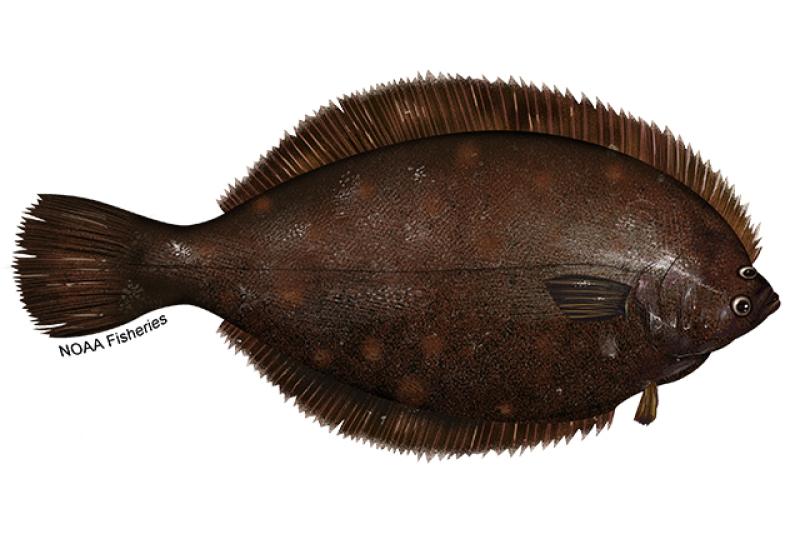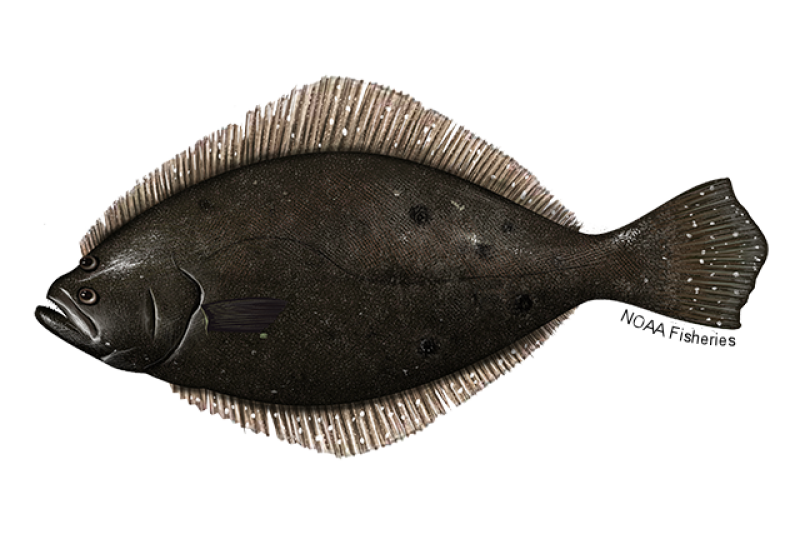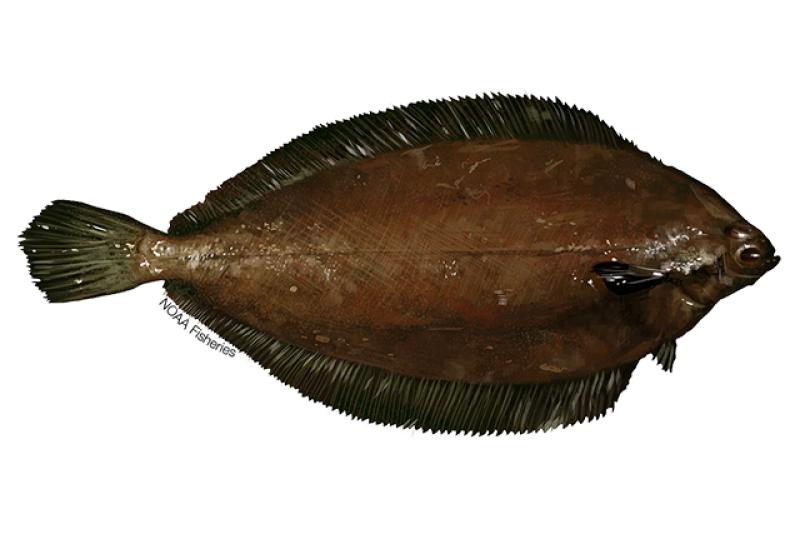 Winter flounder in eelgrass habitat. Credit: NOAA Fisheries
Winter flounder in eelgrass habitat. Credit: NOAA Fisheries
Winter flounder in eelgrass habitat. Credit: NOAA Fisheries
About the Species
 Winter flounder in eelgrass habitat. Credit: NOAA Fisheries
Winter flounder in eelgrass habitat. Credit: NOAA Fisheries
Winter flounder in eelgrass habitat. Credit: NOAA Fisheries
U.S. wild-caught winter flounder is a smart seafood choice because it is sustainably managed and responsibly harvested under U.S. regulations.

Population
The Southern New England/Mid-Atlantic and Georges Bank stocks are not overfished. The Gulf of Maine stock has not been assessed, the population level is unknown, and management measures are in place.

Fishing Rate
Not subject to overfishing.

Habitat Impact
Area closures and gear restrictions protect habitats that are affected by some kinds of trawl gear.

Bycatch
Regulations are in place to minimize bycatch.
Population Status
- In U.S. waters, there are three stocks of winter flounder: Georges Bank, Southern New England/Mid-Atlantic, and Gulf of Maine. According to the most recent stock assessments:
- The Georges Bank stock is not overfished but still rebuilding, and is not subject to overfishing (2022 stock assessment). Summary stock assessment information can be found on Stock SMART.
- The Southern New England/Mid-Atlantic stock is not overfished, not subject to overfishing, and has rebuilt to the target population level (2022 stock assessment). Summary stock assessment information can be found on Stock SMART.
- The Gulf of Maine stock is not subject to overfishing and the overfished status is unknown because the population size could not be estimated due to highly uncertain assessment results (2022 stock assessment). Summary stock assessment information can be found on Stock SMART.
Appearance
- Winter flounder have an oval shape and a thick body.
- Their eyes are on the right side of their body.
- They have a straight lateral line and dark coloring.
- Their coloring often varies with their habitat, ranging from muddy to slightly reddish brown, olive green, or dark slate, to an almost black upper side.
- Their underside is white, and their dorsal and anal fins are often tinged with pink, red, or yellow.
Biology
- Winter flounder live 15 to 18 years and grow to more than 2 feet in length.
- They spawn during the winter and spring in shallow inshore waters, often returning to the same areas where they were born to spawn.
- Females usually produce between 500,000 and 1.5 million eggs.
- They deposit their eggs on sandy bottoms and algal mats at night, usually about 40 times every spawning season.
- Newly hatched larvae have one eye on each side of the head.
- Five to six weeks after they hatch, larvae settle to the bottom to begin their transformation into juveniles.
- After weeks of adapting to living on the bottom, their left eye migrates to the right side of their body and their metamorphosis is complete.
- The growth and survival rates of larvae and juveniles depend on several factors, including temperature, salinity, water quality, and the availability of food.
- Winter flounder feed during the day because they depend on sight to locate prey.
- Their small mouths limit what they can eat.
- They feed on small invertebrates, shrimp, clams, and worms.
- Fish (mainly striped bass, bluefish, toadfish, and summer flounder), birds, invertebrates, winter skate, and marine mammals prey on larval and juvenile winter flounder.
- Atlantic cod, spiny dogfish, and monkfish prey on adults.
Where They Live
Range
- Winter flounder are found in estuaries and on the continental shelf of the Northwest Atlantic, from the Gulf of St. Lawrence, Canada to North Carolina. They are most common north of Delaware Bay.
Habitat
- Winter flounder get their name because of their migrations. In the winter, adults migrate from offshore areas where they feed to inshore bays and estuaries where they spawn.
- While inshore, they live on muddy sand, clean sand, clay, and pebbly or gravelly bottom habitats.
- They often bury their whole body, except for their eyes, in bottom sediments.
- Larvae and some 1-year-olds live in the estuaries where they were born.
- Juveniles prefer sand or sand-silt bottoms with a wide range of salinity and temperature.
Fishery Management
- There are three stocks of winter flounder in U.S. waters, the Gulf of Maine, Georges Bank, and Southern New England/Mid-Atlantic stocks.
- NOAA Fisheries and the New England Fishery Management Council manage the fishery in federal waters. The Atlantic States Marine Fisheries Commission coordinates management of winter flounder in state waters (0 to 3 miles offshore).
- Winter flounder, along with other groundfish in New England waters, are managed under the Northeast Multispecies Fishery Management Plan, which includes:
- Permitting requirements for commercial vessels.
- Separate management measures for recreational vessels.
- Time/Area Closures to protect spawning fish and habitat.
- Minimum fish sizes to prevent harvest of juvenile fish.
- Annual catch limits, based on best available science.
- An optional sector (catch share) program can be used for winter flounder and other groundfish species. The sector program allows fishermen to form harvesting cooperatives and work together to decide when, where, and how they harvest fish.
- A rebuilding plan to rebuild the Georges Bank stock to the target population level is in place with a target date of 2029.
Harvest
- Commercial fishery:
- In 2023, commercial landings of winter flounder totaled approximately 821,000 pounds, and were valued at $1.6 million, according to the NOAA Fisheries commercial fishing landings database.
- Gear types, habitat impacts, and bycatch:
- Winter flounder are commonly harvested using trawl nets and to a lesser extent gillnets.
- Areas closures and gear restrictions reduce habitat impacts from trawl nets. Fishermen follow management measures to designed to reduce interactions with marine mammals, including gear modifications, seasonal closures, and use of marine mammal deterrents.
- Recreational fishery:
- There is a small recreational fishery for winter flounder. Anglers use bait to target flounder in nearshore waters.
- Regulations include seasons, minimum fish sizes, and possession limits.
Scientific Classification
- Winter flounder are found in estuaries and on the continental shelf of the Northwest Atlantic, from the Gulf of St. Lawrence, Canada to North Carolina. They are most common north of Delaware Bay.
- Winter flounder get their name because of their migrations. In the winter, adults migrate from offshore areas where they feed to inshore bays and estuaries where they spawn.
- While inshore, they live on muddy sand, clean sand, clay, and pebbly or gravelly bottom habitats.
- They often bury their whole body, except for their eyes, in bottom sediments.
- Larvae and some 1-year-olds live in the estuaries where they were born.
- Juveniles prefer sand or sand-silt bottoms with a wide range of salinity and temperature.
Fishery Management
- There are three stocks of winter flounder in U.S. waters, the Gulf of Maine, Georges Bank, and Southern New England/Mid-Atlantic stocks.
- NOAA Fisheries and the New England Fishery Management Council manage the fishery in federal waters. The Atlantic States Marine Fisheries Commission coordinates management of winter flounder in state waters (0 to 3 miles offshore).
- Winter flounder, along with other groundfish in New England waters, are managed under the Northeast Multispecies Fishery Management Plan, which includes:
- Permitting requirements for commercial vessels.
- Separate management measures for recreational vessels.
- Time/Area Closures to protect spawning fish and habitat.
- Minimum fish sizes to prevent harvest of juvenile fish.
- Annual catch limits, based on best available science.
- An optional sector (catch share) program can be used for winter flounder and other groundfish species. The sector program allows fishermen to form harvesting cooperatives and work together to decide when, where, and how they harvest fish.
- A rebuilding plan to rebuild the Georges Bank stock to the target population level is in place with a target date of 2029.
Harvest
- Commercial fishery:
- In 2023, commercial landings of winter flounder totaled approximately 821,000 pounds, and were valued at $1.6 million, according to the NOAA Fisheries commercial fishing landings database.
- Gear types, habitat impacts, and bycatch:
- Winter flounder are commonly harvested using trawl nets and to a lesser extent gillnets.
- Areas closures and gear restrictions reduce habitat impacts from trawl nets. Fishermen follow management measures to designed to reduce interactions with marine mammals, including gear modifications, seasonal closures, and use of marine mammal deterrents.
- Recreational fishery:
- There is a small recreational fishery for winter flounder. Anglers use bait to target flounder in nearshore waters.
- Regulations include seasons, minimum fish sizes, and possession limits.
Scientific Classification
| Kingdom | Animalia | Phylum | Chordata | Class | Actinopterygii | Order | Pleuronectiformes | Family | Pleuronectidae | Genus | Pseudopleuronectes | Species | americanus |
|---|
Last updated by NOAA Fisheries on 03/21/2025
Featured News
NOAA Fisheries Partners with Northeast Groundfish Industry to Update Key Data for Stock Assessments
 Fisherman Rob Green measures a cod while participating in the Recreational Biological Sampling, or RecBio Program. Credit: Willy Goldsmith
Fisherman Rob Green measures a cod while participating in the Recreational Biological Sampling, or RecBio Program. Credit: Willy Goldsmith
New England For-Hire Groundfish Fleet Partners with NOAA Fisheries to Improve Cod Data
 The NOAA research vessel Gloria Michelle conducts groundfish surveys in New England, an important mission to support science-based fisheries management. Photo credit: NOAA Fisheries
The NOAA research vessel Gloria Michelle conducts groundfish surveys in New England, an important mission to support science-based fisheries management. Photo credit: NOAA Fisheries
As Fishing Season Opens, NOAA Implements Emergency Action to Ensure Uninterrupted Northeast Fisheries
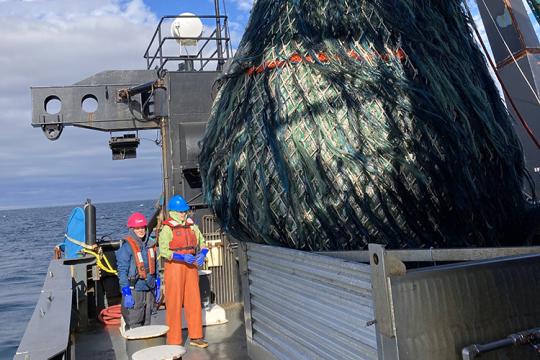 After each survey tow, the net is retrieved and the catch is emptied into a hopper where a series of conveyors move the catch to the sorting and processing area aboard the NOAA Ship Henry B. Bigelow. There, scientists sort the catch and collect data and biological samples. Credit: NOAA Fisheries/Jessica Blaylock
After each survey tow, the net is retrieved and the catch is emptied into a hopper where a series of conveyors move the catch to the sorting and processing area aboard the NOAA Ship Henry B. Bigelow. There, scientists sort the catch and collect data and biological samples. Credit: NOAA Fisheries/Jessica Blaylock
Seafood Facts

Is Winter Flounder Sustainable?
U.S. wild-caught winter flounder is a smart seafood choice because it is sustainably managed and responsibly harvested under U.S. regulations.
Availability
Year-round.
Source
U.S. wild-caught from Maine to Virginia.
Taste
Mild.
Texture
Lean, boneless, and flaky.
Color
Raw flounder ranges in color from tan to pinkish to snow white. Cooked flounder is pure white.
Health Benefits
Flounder is a good, low-fat source of B vitamins and niacin.
Nutrition Facts
Servings: 1; Serving Weight: 100 g (raw); Calories: 91; Protein: 18.84 g; Total Fat: 1.19 g; Total Saturated Fatty Acids: 0.283 g; Carbohydrate: 0 g; Total Sugars: 0 g; Total Dietary Fiber: 0 g; Cholesterol: 48 mg; Selenium: 32.7 mcg; Sodium: 81 mgMore Information
Flounder Recipes
Looking for some ways to add flounder into your rotation? If you need some cooking inspiration, browse these recipes for baked flounder with herbs, stuffed flounder, and more!
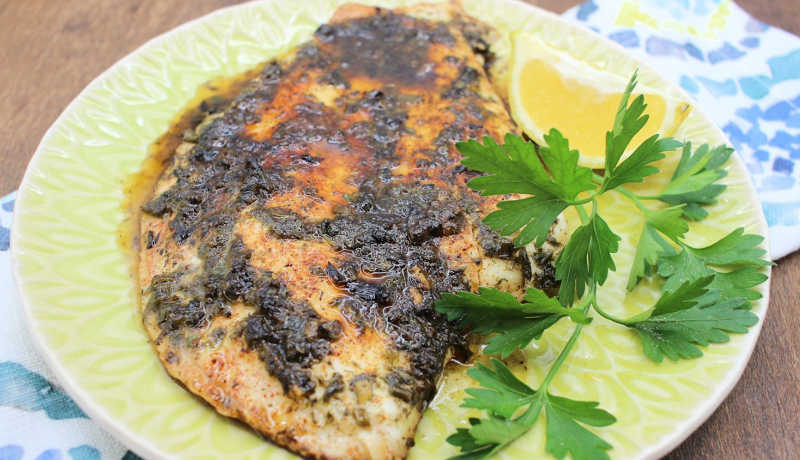
Last updated by NOAA Fisheries on 03/21/2025
Seafood News
 Credit: NOAA Fisheries and Partners
Credit: NOAA Fisheries and Partners
Part 2: Seafood Tips from the People Bringing You America's Seafood
 Commercial fishing boats lined up in Sitka, Alaska. Credit: Shutterstock.
Commercial fishing boats lined up in Sitka, Alaska. Credit: Shutterstock.
NOAA Fisheries Seeks Recommendations for Restoring American Seafood Competitiveness

Celebrate Seafood This Holiday Season

Part 1: Seafood Tips from the People Bringing You America's Seafood
Management Overview
Winter flounder is managed under the Northeast Multispecies (Groundfish) Fishery Management Plan (FMP) along with 12 other species of groundfish. Collectively, these 13 species are referred to as the Northeast multispecies complex.
Learn more about the Northeast multispecies complex and its management
Last updated by NOAA Fisheries on 03/21/2025
Research
Fisheries Ecology in the Northeast
We study the relationship between marine life and their environment to support sustainable wild and farmed fisheries on the Northeast shelf, creating opportunities and benefits for the economy and ecosystem.
Last updated by NOAA Fisheries on 03/21/2025
